Codesign in West Africa
- Kristophe Zephyrin
- Sep 5, 2021
- 3 min read
Updated: Aug 17, 2022
Early 2020 WPI's Development Design Lab sent its first cohort of students to Ghana to learn alongside various groups in the Eastern Region. I served on the bridge development team, a.k.a the Bridge Buddies, to co-design and construct bridges in the village of Dwenase.

Project Overview
This project focused on the co-design and construction of two bridges alongside residents in Dwenase, Ghana. Working with our partners was about sharing knowledge we learned in the classroom with their knowledge of their home. These two cultures clashed early as we had our ideas about how things should be and they had their ideas. We began thinking that we would educate our partners on these processes to advance their community and help them learn skills to further their careers. Ultimately, we hoped to use the design and construction of bridges as a vehicle to provide hope and show the community that they can create their own solutions to their problems. This allows them to become self-sufficient from outside agents, including Western influences and their own government, and leads to the creation of sustainable solutions to their problems. The bridge design and development project can help demonstrate the ability of the locals within Dwenase to execute their own development projects that address significant local issues. We learned, too, however. Through the course of the project we internalized the art of active listening, participating in thoughtful conversation, remaining open-minded to project fluidity, and having an empathic presence. The challenge of actively applying these personal character traits is what helped our team grow as individuals and professionals.

Problem statement & Project Goals
This project will aim to replace a makeshift bridge in the town of Dwenase, Ghana. Currently, the town has a small bridge constructed with mahogany planks over a culvert that has become dangerous to cross during everyday use (Figure 1). In particular, the heavy traffic of detours during community gatherings results in unsafe conditions. Recently, a portion of the existing structure collapsed when a loaded cocoa truck drove over it and subsequently fell off the side of the bridge. In addition to the potential effects of a collapse, the makeshift bridge reduces traffic along the local road and increases traffic on other area roadways.

Figure above: The existing makeshift bridge in Dwenase, Ghana
This bridge is emblematic of several bridges in Dwenase and in the larger general area. This project will also address the deficit of construction knowledge about bridges in the local area by working with Basic Design and Trade students at the Dwenase Junior High School. These students will be a part of the design process and the conversation with the village to determine the best strategies regarding local norms and practices. This includes determining supplies, tools, designs, and requirements based on the culture of the area. Ultimately, students will be able to replicate the design and construction process.
Design challenges within this project will be produced by both the location of the project and the technical aspects of the project. Because the new bridge will be built in a small village in Ghana, cultural norms will need to be addressed, construction practices and materials will need to come from the local area, and the design should allow simple maintenance and repairs. Prior to the physical construction of the bridge, the specifications of the culvert and the surrounding terrain and the load requirements will be determined.























Comments